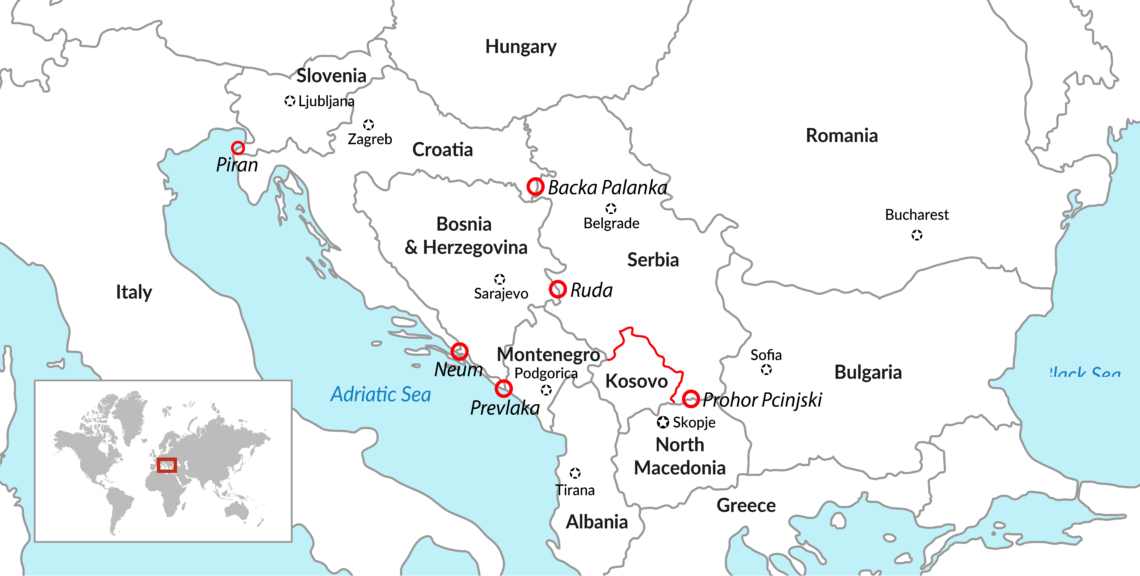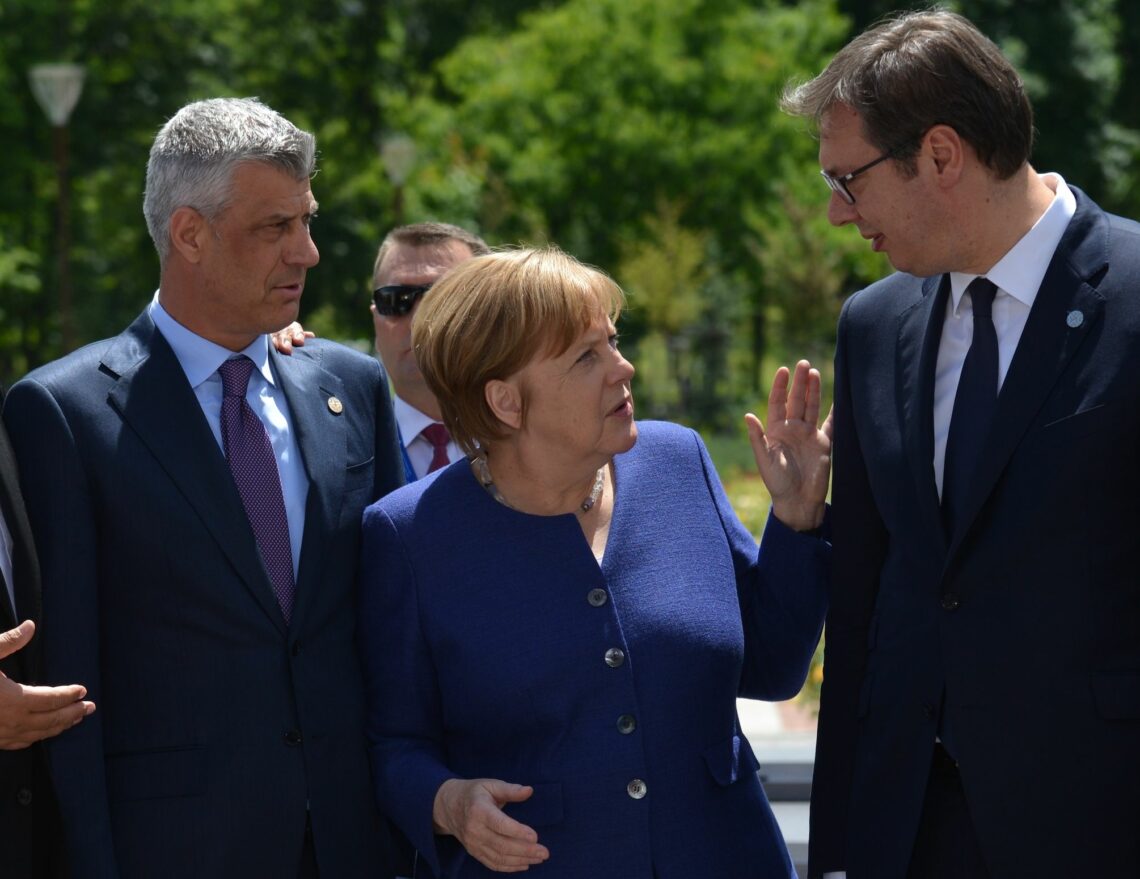Border conflicts in the Balkans
Nearly three decades after the breakup of Yugoslavia, the borders in the Balkans are still debatable. Unresolved border disputes are dividing countries in the region, pitting EU and NATO members against each other. Some of these disputes will likely last for years to come, as the enmity of past conflicts gets in the way of negotiations.

In a nutshell
- Eight border disputes are still dividing the Balkan countries, years after war
- Some of these conflicts, such as between Serbia and Kosovo, may not be resolved for a decade or more
- The unresolved disputes may threaten the EU candidacy of countries like Serbia and Albania
Almost three decades after Yugoslavia’s dissolution, the new borders of the Balkans are still not fixed and will likely remain so for the next decade. Only a few bilateral demarcation agreements between the former federal units have been signed, and each of the countries has unresolved boundary issues that may remain open for years to come.
These territorial disputes will most likely lead to a delayed stabilization of the Balkans. As German Chancellor Angela Merkel has said, there is still a “fragile peace” in the region. Less likely, the EU and NATO may accept new member states from the Balkans despite the border issues.
Historically, borders in the Balkans have been drawn and redrawn many times, from the Berlin Congress in 1878 to conferences in London (1913), Versailles (1919) and Paris (1945). Border issues in the Balkans have generally been reopened by wars and closed by diplomacy. In 1975, the parties at the Helsinki Conference promulgated a key principle of maintaining the territorial status quo at the time, but once the Cold War ended, the borders were again changed. Through it all, the region’s boundaries have always been drawn in pen but backed up by bullets.
Eight open disputes
In November 1991, at the commission advising on legal questions regarding the breakup of the republics, President of the International Peace Conference on Yugoslavia Lord Carrington asked whether the internal boundaries between Croatia, Serbia and Bosnia and Herzegovina could be considered borders under international law. In its report, the commission replied that as Yugoslavia was in the process of dissolution, the former internal boundaries should become frontiers protected by international law unless otherwise agreed.
It was expected that this interpretation would be respected by all the former Yugoslav republics. But 27 years later, the new states have not resolved all of their border disputes. Only this April, Montenegro and Kosovo ratified the Demarcation Treaty (it was signed in 2015), just as Macedonia and Kosovo did in 2008.
Unresolved border disputes may have serious consequences for EU candidate countries.
Eight border disputes remain unresolved, involving new Balkan states that emerged from Yugoslavia, existing EU and NATO member states, and several Balkan countries that are currently candidates for entry into the EU. The consequences of unresolved border disputes may be especially significant for those candidates’ chances at integration.
Facts & figures
Eight border disputes in the Balkans
- Piran Bay, a sea border between Slovenia and Croatia
- The Prevlaka peninsula, contested by Croatia and Montenegro
- Kosovo’s border with Serbia, which still claims the state as its own territory
- Backa Palanka, near an area claimed by both Croatia and Serbia
- Three contested sites on the Bosnian-Serbian border
- The Prohor Pcinjski Monastery claimed by both Serbia and Macedonia
- Neum, a Bosnian port on the Adriatic Sea with areas contested by Croatia
- The maritime border between Albania and Greece
Alliance members clashing
Slovenia and Croatia, both NATO and EU members, are fighting over 670 kilometers of sea borders in Piran Bay. Though both governments signed the Drnovsek-Racan Agreement in July 2001, it has only been ratified by Slovenia, not Croatia. An arbitration agreement was signed in November 2009, and a court ruling decided in 2017 on the final demarcation between the two states.
That decision has still not been accepted. European Commission President Jean-Claude Juncker has called for an “urgent bilateral solution,” warning that such disputes will not be tolerated of new EU member states. In June 2018, Slovenia decided to take Croatia to court for non-implementation of the arbitration ruling.
On its border with Montenegro, also a NATO member, Croatia faces a dispute over the Prevlaka peninsula, in the Adriatic Sea. In practice, under a 2002 interim regime with a land border in Konfin, the disputed land is Croatian and the sea a “mixed zone.” It is unlikely that the Montenegro-Croatia dispute will harm bilateral relations between the two countries.
Not going away
Many of Serbia’s borders are at least somewhat contested, and the country is involved in two of the region’s thorniest border disputes, which are likely to remain unresolved for at least another decade: with Kosovo and with Croatia.
The dispute between Serbia and Kosovo will be the hardest border dispute in the region. Due to a lack of bilateral diplomatic relations, resolving it will likely take years. To fix interstate borders, both countries should mutually recognize each other, but that is unlikely in the medium term.
Serbia is involved in two of the region’s thorniest border issues, likely to remain unresolved for at least a decade.
Serbia insists that Kosovo is an “integral part” of its territory and treats Kosovo’s borders as “administrative.” For Kosovo, its borders are international. Kosovo made official its demarcation agreements with Macedonia and Montenegro, in 2008 and 2018 respectively, and maintains an international border with Albania. Only its Serbian border dispute remains unresolved.
Having officially established several of its international borders, Serbia is not likely to convince Kosovo of a different border regime than it has with its other neighbors. But for Serbia, not fixing the dispute with Kosovo will have political and technical consequences. Insisting that Kosovo should be part of Serbia – even though realistically, Belgrade has no sovereignty there – will remain the main obstacle when it opens the EU’s Chapter 35 on resolving “other issues” before integration.
As Chancellor Merkel made clear to Serbian President Aleksandar Vucic during his visit to Berlin in April 2018, new EU members should not have open territorial issues. That same line has been repeated in Washington and by the NATO Quint (an informal decision-making group consisting of the United States, France, Germany, Italy and the United Kingdom). Abroad, Mr. Vucic is seeking support from Russian President Vladimir Putin. But inside the country, only 46 percent of Serbians consider Kosovo a top priority, and it is unlikely that Belgrade will ignore this kind of “advice” from the West.
One scenario is that Serbia will recognize the Republic of Kosovo unconditionally, and then ask for compensation in the form of Northern Kosovo – a so-called “Serbian secret plan.” Most likely, Kosovo would not accept the loss of its territory, but it would be possible (though unlikely) that the international community would allow the change.

If they do, the only realistic outcome would be a territorial swap based on ethnic criteria: Northern Kosovo (majority Serb) for Southern Serbia (majority Albanian). The idea became a top media theme this summer after a Brussels meeting between Mr. Vucic and Kosovar President Hashim Thaci.
Surrounded by uncertainty
Serbia is engaged in further disputes on three other borders. After the war, both Serbia and Croatia have tried since 2003 to resolve their border dispute along the Danube River at a point near the town of Backa Palanka. Croatia insists on 11,500 hectares on the eastern side of the Danube, while Serbia, based on a law passed by the Vojvodina Assembly of 1946, is asking for 900 hectares on the west side of the river.
In February 2018, Croatian President Kolinda Grabar-Kitarovic and Serbian President Vucic declared that border negotiations would not start for at least two years. Recent tensions between the two countries will most likely delay any further attempts at a resolution. The dispute will probably postpone Serbia’s integration into the EU, as Croatia is already a member state.
Another hot issue for Belgrade is its border with Bosnia and Herzegovina. In a somewhat unlikely scenario, three difficult border disputes may be resolved in the coming years: Ruda, in southern Bosnia; the hydroelectric area by the River Drina; and 12 km of Bosnian territory that Serbia wants for a railway to Montenegro. Other than these three areas, the hardest issue that will threaten the countries’ future relations will be Republika Srpska, the Serb-dominated entity in Bosnia.
Another summit on the Balkans is wishful thinking, particularly given President Putin’s resurgent Russia.
Finally, for Serbia, while its border with Macedonia near the Prohor Pcinjski Monastery is unresolved, it is unlikely that this low-level dispute will present serious problems. The monastery, built in the 11th century and reconstructed by Serbian kings, has religious importance for Serbia. But Macedonians hold it dear for political reasons; in 1944, it hosted the first session of the Anti-Fascist Assembly for the National Liberation of Macedonia (ASNOM), an early foundation stone of the state.
Rich waters
Another regional dispute concerns Croatia and Bosnia, though not very significantly. The countries share a 1,000 km border and both signed the Tudjman-Izetbegovic Agreement, which was ratified by Bosnia but not Croatia. The main remaining problem is the seaport of Neum, which is Bosnia’s only access to the Adriatic Sea. The city may also have energy importance, after recently-discussed plans for a possible liquefied natural gas port there. It is unlikely that this dispute will heighten tensions between the two countries.
Lastly, the region’s eighth dispute divides Greece, a member of the EU and NATO, and Albania, a NATO member that is on the path to EU integration. The conflict has two dimensions. Technically, the two countries are still at war due to Greece’s “Law on War” with Albania (1940), which has never been abrogated. Based on that law, the Cham Albanian population was expelled from its native territory on the coast of the Ionian Sea, with their land sequestered by the Greeks. More than 1,800 such land cases belonging to Cham Albanians have been noted, but Athens refuses to return their property.
In 2008, Greece raised another dispute with Albania over the Ionian Sea, for economic reasons. These borders have been decided by many acts of international law, from the London Conference of 1913 through a 1925 agreement and the Final Act on the delimitation of Albanian borders (1926). Although Greek Foreign Minister Nikos Kotzias recognized the 1926 agreement, Athens has requested a new border drawing.
Mutual enmity persists in the Balkans, and thousands of people are still missing from the last wars.
The foreign ministers from both countries signed a bilateral agreement in April 2009 but it was not enforced after a legal ruling in Albania over the loss of six miles of Albanian waters. This contested area is rich with resources, including 4 billion cubic meters of oil and 1.5 billion cubic meters of gas; together, it could be worth $20 billion in the next two decades.
In 2013, the new Albanian government abolished that agreement and in 2015 Albanian Prime Minister Edi Rama declared that he will protect the territorial integrity of the country. New bilateral negotiations started in 2017, but before it was expected to be concluded by the visit of Greek Prime Minister Alexis Tsipras, it was canceled in the last moment and postponed for June 2018; now, the negotiations are continuing.
Scenarios
There are three possible scenarios. The most likely is that the border disputes in the Balkans will not be resolved for at least another decade, due to lack of political will on behalf of the former enemies of the Balkan wars. If soft demarcation cases that were actually resolved took three years to conclude, the harder border cases will take longer.
For example, the case of Serbia-Croatia may be solved in the next five years, but not the Kosovo-Serbia dispute, which will not even see the end of five years of “Brussels Dialogue” until 2019. Only after a normalization of their bilateral relations – which would likely be concluded in 2020 by a legally binding agreement – can their issues be solved.
Under this scenario, a final map of the Balkans would not come before 2025, which coincides with the timeframe announced by Mr. Juncker of a new EU member state possibly joining the club.
It is likely that Serbia will continue to receive support from Russia, and likewise Croatia and Kosovo from the West. Alternatively, though less likely, Serbia may ignore “advice” from Washington and Brussels on EU membership, expecting a veto in the EU Council regardless from Croatia.
As far as the case of Albania and Greece, a resolution would require involvement not only of big powers, but also regional factors. If Athens insists on new border lines in the Ionian Sea, it will push Albania toward Turkey, which itself has a history of territorial tension with Greece over Cyprus and the Aegean Islands. The recent Turkish plan to build Albania’s second airport in Vlore, a city near the contested coastal border, is one example. And NATO recently decided to build an air base in Kucove, Albania, which would be its first in the Western Balkans.
Another scenario is that the border disputes, instead of being fixed bilaterally, may be resolved by a new multilateral territorial exchange package. Here, again, the hard bargaining would be between Serbia and Kosovo. If it is not able to take northern Kosovo, Serbia will ask for Republika Srpska; Kosovo, for its part, would ask for the Presevo Valley, which controls Corridor 8 and the Belgrade-Athens highway.
That scenario would work only with significant international involvement, and with other crises raging in places like Syria, Iran and Ukraine, such an effort is not likely to happen in the short term. Another Balkans conference after the one in 1991 is wishful thinking, particularly when one compares President Vladimir Putin’s resurgent Russia with Boris Yeltsin’s version.
The least likely scenario is a quick resolution of all border issues – a desirable but unrealistic outcome. Mutual enmity persists, and thousands of people are still missing from the last wars. One hundred thousand people were victims of those wars and another 100,000 were displaced, not to mention the approximately 500,000 who emigrated. In these conditions, conflicts cannot be solved quickly.
In the Balkans, an objective problem (the borders) has a subjective component: the victims. Without real reconciliation, it is hard to expect a prompt solution to any territorial disputes.








